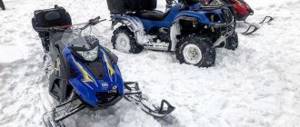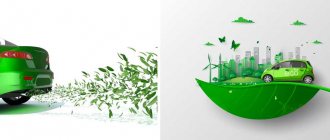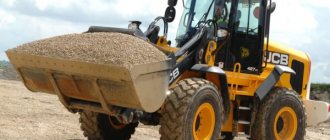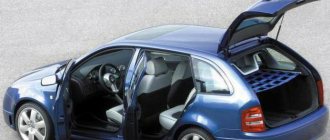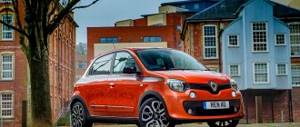What is a self-propelled car
To be considered as such, a self-propelled vehicle must meet the following requirements:
- move on the ground;
- have independent drive (that is, trailers are not suitable);
- have an internal combustion engine (petrol/diesel, it doesn’t matter) with a volume of more than 50 cubic centimeters or an electric motor with a power of more than 4 kilowatts.
It is separately mentioned that the number of “self-propelled guns” also includes tractors.
The exception is vehicles with a maximum speed of more than 50 km/h and various self-propelled military equipment belonging to the Armed Forces, as well as other bodies that ensure state security (for example, the FSB).
Tractors belong to the category of self-propelled equipment
Is a self-propelled car a vehicle?
Undoubtedly. This can be understood by reading the same paragraph 1 of section 1 of the Rules. Indeed, in the definition, a self-propelled machine is directly called a vehicle.
In turn, the current version of the Russian Federation Traffic Regulations (section 1, clause 1.2) states that motor vehicles include, among other things, tractors and other self-propelled vehicles. The main thing is that the transport is intended to transport people and goods. If there is no engine, then the vehicle ceases to be merely mechanical (as is the case with bicycles). So, the question of whether a tractor is a vehicle or a self-propelled machine does not make sense, because it is both at the same time.
A self-propelled gun legally imported into our country or produced in it must have an appropriate passport (PSM) - an analogue of PTS, but its type is somewhat different.
Category C: excavator operator, diesel forklift driver
The types of vehicles in category “C” are similar to the previous category, but differ in increased engine power. Persons who have completed training as an excavator operator and passed the exam receive a certificate from Gostekhnadzor with this particular permitted category.
| Category | Description | Vehicles | Restrictions | |
| Category C | wheeled vehicles with an engine power from 25.7 to 110.3 kW | excavator, tractor type MTZ-80 "Belarus" | over 17 years old. | sign up |
see also
- The combine is the final event (running and shooting) in modern pentathlon
Wikimedia Foundation. 2010.
Synonyms
:
See what a “Combine Harvester” is in other dictionaries:
- COMBINE - (English combine, literally connection), an aggregate is a collection of working machines that simultaneously perform several different operations, for example a combine in agriculture, everyday life (food processor), a mountain harvester ... Modern encyclopedia
- COMBINEER - COMBINEER, a and COMBINEER, a, husband. Combine driver (2 digits). | wives combine operator, and (colloquial) and combine operator, and (colloquial). | adj. combiner, aya, oh and combiner, aya, oh. Ozhegov's explanatory dictionary. S.I. Ozhegov, N.Yu. Shvedova. 1949 1992 ... Ozhegov's Explanatory Dictionary
- COMBINE - (English combine, lit. connection), an aggregate is a set of working machines that simultaneously perform several different operations (for example, a combine in agriculture, everyday life, a mining machine) ... Big Encyclopedic Dictionary
- COMBINE - COMBINE, harvester, man. (English combine) (neol., tech.). A complex machine that simultaneously performs the work of several machines. Agricultural combine (for harvesting bread). Coal or mining combine (for coal mining). Ushakov's explanatory dictionary. D.N... Ushakov’s Explanatory Dictionary
- harvester - steppe ship; unit Dictionary of Russian synonyms. combine noun, number of synonyms: 16 • video combine (1) • ... Dictionary of synonyms
- COMBINE - COMBINE, huh, husband. 1. Complex machine, a unit that performs the work of several simpler machines. Woodworking plant. Mining plant (in mines, quarries). Kitchen cabinet (set of mechanisms for the kitchen). 2. Such an agricultural machine designed ... Ozhegov’s Explanatory Dictionary
- Combine harvester - A combine harvester is a complex grain harvesting machine (reaping thresher), which performs sequentially in a continuous flow and at the same time: cutting bread, feeding it to the threshing apparatus, threshing grain from the ears, separating it from the heap and other ... Wikipedia
- combine - Table 45. Combine “Don”: 1 reel, brings the stems to the cutting device and the header auger; 2 header auger, ensures supply of the mown mass into the window of the feeder chamber; 3 inclined chamber, transports the grain mass to... ... Agriculture. Large encyclopedic dictionary
- COMBINE - (English combine, lit. connection), a machine for simultaneous execution of at least 3 technologies. With. X. cleaning operations. For the first time under the name. “Horse-mounted standing grain harvesting” was proposed by Russian. agronomist A. R. Vlasenko (1868, Tver province). K.... ...Agricultural encyclopedic dictionary
- COMBINE - (English combine, lit. connection) a complex unit, which is a collection of working machines that simultaneously perform several tasks. various operations. Most widely varied. types of K. are used in villages. x ve (see Combine harvester. ... ... Big Encyclopedic Polytechnic Dictionary
Books
- Food processor, . A food processor can change your life in the kitchen beyond recognition. It doesn’t matter whether you prepare simple dishes or confidently tackle complex ones. Everything related to grinding... Read more Buy for 337 RUR
- Food processor, . New design for the already beloved, successful series. Stylish, exclusive, bright cover. Only proven and uncomplicated recipes for preparing dishes such as classic, traditional,… Read more Buy for 249 rubles
- Food processor, . A food processor can change your life in the kitchen beyond recognition. It doesn’t matter whether you prepare simple dishes or confidently tackle complex ones. Everything related to grinding... Read more Buy for 239 RUR
Other books on request “Combine” >>
What is special equipment?
The definition of what special equipment is is characterized by a list of mechanisms, vehicles or machines. There are many varieties of universal or narrowly targeted purpose. The vastness of the scope of application and the complexity of the device do not allow people who are far from the development of such machines to answer the question without preparation of what it is - special equipment. The scientific interpretation of the term special equipment is:
- complex technical device;
- designed to perform specific jobs, to speed up the process, increase efficiency or increase the efficiency of the overall cycle;
- its creation takes into account the industry in which the technology will be used
Interesting!
Machines for this purpose have variable sizes, from small-sized, for example, nano-robots, to huge sizes - spaceships.
The use of mechanisms, vehicles, units, devices that fall under the broad definition of types of special equipment simplifies work in various spheres of human life. For example, there are vehicles for transporting people, moving, delivering goods, construction or demolition of buildings.
Basic classification of special equipment
The general rule for the differentiation of technology is the variability of the characteristics of differentiation. It is considered according to one or more essential characteristics:
- technical specifications;
- by energy or fuel consumption;
- sizes;
- Areas of use;
- type of construction;
- the quality of the work performed;
- efficiency in comparison with other technology.
The answer to the question, what types of special vehicles are there?
, depends on what information is needed. All special equipment comes in several types:
- aboveground;
- underwater;
- space
It is divided according to general characteristics. To select a vehicle you need to know:
- tasks performed;
- type of machines or mechanisms (for the work of special services, production equipment);
- mode of transportation (stationary, mobile).
Purpose (the specific field of activity for which the equipment was created determines the type of propulsion - tracked, wheeled, flying, rail).
The main categories are distinguished by application in a specific field of activity. These may include different types of equipment.
City municipal special equipment
photo from the Internet
An extensive list of machines, mechanisms, and means to serve urban needs - from street cleaning to liquidation of consequences
- domestic accidents, natural disasters:
- garbage trucks;
- snowblower;
- special vehicles for cleaning, watering roads, lawns, parklands, spreading gravel or sand during icy conditions;
- machines for pumping out sewer pits.
In public utilities there are highly specialized types of transport and universal vehicles equipped with attachments, depending on the tasks assigned.
Transport cargo special equipment
Photo from the Internet
The purpose of cargo vehicles is to move, tow, and deliver cargo. Listing of what relates to transport cargo
- special equipment, is determined by the specifics of processes in the field of transport and the needs that arise during vehicle migration:
- dump trucks, trucks;
- loaders, lifts, elevators;
- tugs, barges, pushers;
- tankers, cargo ship equipment;
- transport aircraft, helicopters;
- tow trucks, manipulators.
Transport cargo equipment works when transporting, moving goods or vehicles on land, water, in the air, hence the long list, distribution in life.
Construction equipment
Photo from the Internet
Construction equipment is another broad category of special machines. It is used for the construction of various objects: from small warehouses to multi-storey residential complexes. The following types of construction equipment are distinguished:
- excavators, bulldozers;
- truck cranes, pipe layers, pile driving machines;
- concrete mixers, concrete feeding machines.
Interesting!
In construction, highly specific, high-tech mechanisms are used, developed for individual processes - drilling wells, laying communications, sewerage, assembly, destruction of construction waste, installation of piles.
Mining special equipment
Photo from the Internet
The list of mining equipment includes research, production, transport and cargo vehicles designed for exploration, mining, and transportation. In this industry, mechanisms and mobile vehicles are used, designed for the development of deposits and the extraction of minerals. The most common:
- piling machines, lifts;
- drilling masts, platforms;
- pipelayers;
- vibratory hammers;
- bulldozers.
Quarry units cope with increased loads, prove their effectiveness by performing the most complex tasks
.
Rescue equipment
Photo from the Internet
Such machines are needed for special purpose parts. Designed to eliminate emergencies and provide assistance. The use of special-purpose transport is regulated by a number of documents and laws - Federal Law (“On Communications”, “On Operational Investigative Activities”), departmental regulations, and the Regulations of the Federal Penitentiary Service for carrying out operational measures to search for escaped criminals or prevent escapes. This includes:
- rescue equipment of the Ministry of Emergency Situations - cars, boats, boats, planes, helicopters;
- ambulance transport - intensive care vehicles to save a child;
- ATS vehicles - metal detectors, security alarms, official vehicles, walkie-talkies.
Use is regulated by the laws of the Russian Federation and departmental instructions, purchase and write-off - by tax regulations.
Such vehicles have been fully implemented, but are used only in certain departments, for example, special fire vehicles - tank trucks, air transport, pumping stations for fire extinguishing.
Classification of rights to a tractor
A tractor driver's license allows you to drive self-propelled vehicles in accordance with the specified category. The latest changes to the classification of “tractor” rights were approved in December 2011. From now on, the following types of driver's licenses for self-propelled vehicles are valid:
- A1 - off-road transport, the maximum speed of which does not exceed 50 km/h;
- A2 - passenger off-road transport, whose weight does not exceed 3.5 tons, the number of passenger seats is up to 8;
- A3 is a vehicle not intended for public roads. The vehicle weight exceeds 3.5 tons;
- A4 - off-road vehicles with more than 8 passenger seats;
- B - wheeled and tracked tractors with engine power up to 25.7 kW;
- C - wheeled vehicles whose power does not exceed 110.3 kW;
- D - wheeled vehicles with a power of over 110.3 kW;
- E - tracked self-propelled vehicles, the power of which starts from 25.7 kW;
- F - heavy-duty self-propelled transport for agricultural purposes.
A tractor driver’s driver’s license is a card with a front and back side that contains information about the driver, the validity period of the document, the institution that issued the license, and also indicates permitting and special marks. A sample of such a certificate is presented in Figure 1.
Figure 1 - Blank form of tractor driver's license
Self-training for any category of driving license for self-propelled vehicles is not permitted. Before taking the driving test, you will need to complete a training course. In addition, to obtain a driver's license, applicants must have a number of additional skills that are considered as categories. Currently, there is the following gradation of ranks when obtaining a license to drive a tractor and other special machines:
- The 2nd category assumes the ability to drive under the guidance of more experienced drivers. There are skills in repairing loading and self-gripping mechanisms;
- The 3rd category represents the control of battery-powered forklifts and lifting mechanisms;
- The 4th category allows you not only to control equipment with a power of over 100 horsepower, but also to independently repair equipment;
- The 5th category involves the management and maintenance of heavy equipment - bulldozers, excavators and other vehicles;
- The 6th category indicates the skills of managing and repairing vehicles with a power of over 200 horsepower.
Each rank upon receipt is entered into the tractor driver’s license. Information such as the driver’s blood type, the obligation to drive with glasses, driving experience, and the presence of a category should be added to the special notes included in the tractor driver’s license.
Basic requirements for drivers
To obtain all of the categories of rights listed above, the driver must meet certain requirements.
To be admitted to the exams you will need:
- Complete specialized training and receive professional basic or additional education. Programs are being studied that are directly or indirectly related to the management of self-propelled vehicles of the listed categories. After completing the courses, you will receive a corresponding document confirming the assigned qualification.
- Pass a special medical examination to obtain a medical certificate. The document must confirm the complete absence of medical contraindications for driving self-propelled vehicles.
Each category of rights requires an appropriate age and a certain length of work experience:
- Category AI - from 16 years old;
- Category A II - from 19 years old, 12 months of experience in automobile category B;
- Category A III - from 19 years old, 12 months of experience in category C;
- Category A IV - from 22 years old, total experience of 12 months for category D driving license;
- Category B, C, E, F—from 17 years old;
- Category D - from 18 years old.
Only if all of the above conditions are fully met can you undergo special training and pass the relevant exams.
Category B: electric forklift, mini excavator
If you have a tractor driver's license with category “B,” you are allowed to drive tracked and wheeled self-propelled vehicles with an engine power of no more than 25.7 kW (34.94 hp). There are no restrictions on engine type for this category.
| Category | Description | Vehicles | Restrictions | |
| Category B | tracked and wheeled vehicles with an engine power of up to 25.7 kW | electric loader, mini-tractor, mini-excavator type JCB 8026 CTS, tractor type T-25, | over 17 years old. | sign up |
This section of the curriculum is chosen by those looking for forklift driver courses. Specialists with a category “B” tractor driver’s license are readily hired by logistics companies and industrial enterprises. In addition, the profession of a tractor driver in this category is in demand in the housing and communal services sector.
Classification by size
Equipment dimensions are an important, but uninformative method of classifying equipment. Types of vehicles by size:
1. Small-sized.
Advantages: maneuverability, compactness, low fuel consumption..
2. Medium-sized.
The vehicles have standard sizes and differ in performance. The models have proven themselves in small and medium-sized businesses.
3. Large-sized.
Advantages - power, large volumes of work, productivity. In agriculture it is a combine harvester, in sawmills it is a forwarder.
4.Oversized.
Vehicles with non-standard dimensions, increased power and carrying capacity, for example heavy-duty BelAZ trucks. According to traffic regulations, oversized equipment can only be moved according to the rules.
“Bagger 293” photo from the network
Interesting!
The largest self-propelled excavator is the Bagger 293, which is 226 meters long and reaches the height of a 30-story building. The variability of machine dimensions helps to maneuver and move over uneven terrain and perform different jobs.
Classification of self-propelled vehicles by category
This division is regulated by the same Rules that were approved by the Government of the Russian Federation on July 12, 1999, by Resolution No. 796. It lists the categories into which these types of equipment are divided. What does it mean? The fact that, if necessary, to drive a particular car, the driver must first open the appropriate category in the “licence”. To do this, you need to pass exams at the Gostekhnadzor department and pay a state fee. The license will indicate not “driver”, but “driver”.
Classification of equipment:
- Category A. This includes vehicles that have a “maximum speed” of 50 km/h or less or do not have access to public roads. Has an additional classification: off-road motorcycles (including snowmobile and ATV); off-road vehicles with a maximum weight of up to 3.5 tons and accommodating up to 9 seated passengers (with driver). For example, small all-terrain vehicles; off-road trucks (over 3.5 tons); off-road buses (more than 9 seats).
- Category B. Wheeled and tracked vehicles, the engine power of which is up to 25.7 kW. For example, a mini excavator or a mini tractor (but not a walk-behind tractor).
- Category C. Wheeled (not tracked!) vehicles with power from 25.7 to 110.3 kW. An example is the MTZ-80 Belarus tractor.
- Category D. This includes any wheeled vehicles with a power of more than 110.3 kW. For example, the mighty K-744 Kirovets tractor.
- Category E. Tracked vehicles with an engine power greater than 25.7 kW. This, in particular, is a bulldozer or snow and swamp-going vehicle like the GAZ-3409 “Beaver”, which is built using a body from Sobol.
- Category F. Agricultural devices. Simply put, any combine – forage harvester, beet harvester, grain harvester, etc. belongs to this category.
Tractor Kirovets
Machines that have a pneumatic drive are classified according to the same criteria as others.
The category of rights to a forklift is determined by its capacity. For small mechanisms this is A, but there are also those that meet the parameters of category B or C. It is unlikely that there will be a roller that fits into A. Usually the roller fits category B, C or D.
In order to drive a crane that is installed on a vehicle chassis and perform work related directly to the crane, you need, in addition to a category C driver’s license, to also obtain a category D tractor driver’s license.
Categories of self-propelled vehicles
It is not difficult to understand the main categories of self-propelled vehicles, as well as the licenses required to operate them. In this case, Resolution No. 796 of July 12, 1999 should be taken as a basis.
It provides information related to the management of machines and the issuance of certificates intended for this process.
The document that allows you to drive a self-propelled vehicle and is issued to the driver is called in 2021, as before, the tractor driver’s license.
The received tractor driver's license may contain entries on certain categories of modern equipment. Each point in the classification of self-propelled vehicles into categories must be considered in more detail.
Category A
Category A is modern motor vehicles that are not intended for travel on public highways or have a maximum speed level not exceeding 50 km/h.
This may include vehicles such as:
- I – these are motorized off-road vehicles – snowmobiles and ATVs.
- II – automobile off-road vehicles with a permissible weight of up to 3.5 thousand kg and a number of passenger seats of no more than eight. This subcategory includes swamp vehicles, vehicles of the side-by-side category and usually those with a body.
- III is a special category of off-road vehicles with a permissible weight above 3.5 tons. An example of these vehicles is an all-terrain vehicle or dump truck of the Ural-Polarnik brand.
- IV – off-road vehicles that are designed to transport passengers, and also have more than eight seats in addition to the driver’s seat. An example here would be an airport bus ramp.
Category B
Category B consists of wheeled and tracked vehicles with engines whose power does not exceed 25.7 kW.
These vehicles can be completely different - gasoline, diesel, and electric.
This category includes the bulk of electric forklifts, mini-tractors and mini-excavators.
Drivers of electric forklifts will need to obtain a tractor driver's license; category B and special o.
Category C
This category includes special wheeled vehicles, the engine power level of which ranges from 25.7 to 110.3 kW. This category of vehicles is the most popular.
This includes:
- Diesel forklifts.
- Loaders of the bucket category.
- Mini variants of Bobcat.
- Some Amcord models.
On a driver's license in this category you can find such marks as tractor driver, loader driver and excavator driver.
If you are wondering what category tractors and other self-propelled machines belong to, then this is precisely category C.
Category D
This category includes special wheeled vehicles equipped with engines with power above 110.3 kW. We are talking about such fairly powerful front loaders as Dresta, Volvo, Caterpillar.
This also includes vehicles designed for transporting sea containers. The certificate may contain marks characteristic of category C.
Category E
These are special tracked vehicles equipped with an engine whose power exceeds 25.7 kW. Driver's licenses of this category are marked with "O" or "excavator operator".
Category F
This category presents all types of modern agricultural machines.
Basic procedure for taking the exam
Exams for obtaining a license intended for driving self-propelled vehicles are taken in a certain sequence:
- Testing theoretical knowledge on the operation of special self-propelled vehicles, their safe operation (except category F).
- Theory for the operation of self-propelled vehicles and agricultural equipment. Available for category F licenses and for those who have already qualified as a tractor driver.
- Passing theory on traffic rules.
- Testing practical knowledge of complex practical driving skills, traffic rules and the safest operation of vehicles.
The practice is completed in two stages. The first part is rented out on a site closed from traffic, which is characterized as a tractor track. The second part is carried out on a pre-selected route, which creates real operating conditions for a self-propelled vehicle.
When passing the practical part of the exam, an employee of the training center will test the following skills:
- starting to move uphill from a standstill;
- turning on a limited-width road with a one-time gear shift;
- putting the car into the box in reverse;
- placing self-propelled vehicles in a unit with a trailer in a box in reverse;
- aggregation of a self-propelled vehicle with a mounted vehicle and a trailer;
- stopping and braking at different speed levels, practicing an emergency stop.
Upon successful passing of all points of the exam, the driver receives a tractor driver's license for driving self-propelled vehicles against receipt.
Important points on self-propelled vehicles
You need to know what categories self-propelled vehicles are divided into and what licenses you need to obtain. The level of security in companies and organizations depends on this.
To drive such vehicles, you must obtain special licenses.
Traffic police officers classify driving self-propelled vehicles with an inappropriate license as driving without a license. Responsibility for violating this rule can be not only administrative, but even criminal.
If the violations are serious enough, not only the perpetrators of the violations and crimes, but also the managers of the companies in which they work can be held accountable.
Punishments are imposed on them for the reason that they allowed the equipment to be controlled by people who do not have the right and proper skills to do so.
Scope of application
The scope of application of special-purpose vehicles is wide. Before finalizing a mechanism into one of the categories, you should carefully consider the technical characteristics, dimensions, manufacturers and primary areas where it is used for its intended purpose.
Building sector
The equipment is designed for the construction or demolition of buildings and residential facilities. Functions of construction machines:
- preparation of the area for construction work, demolition of old objects;
- construction;
- cleaning the area upon completion of construction work.
Large equipment is used in construction.
Road industry
The equipment used is used to prepare the site, clean it, lay the road surface, and subsequently repair the damaged surface. The dimensions of the transport are variable, depending on the tasks performed. Equipment:
- graders;
- asphalt pavers;
- markers;
- demarkers.
The road industry performs important tasks.
Agricultural industry
It is impossible to do without agricultural vehicles in production. To the question “is a tractor a special piece of equipment or not,” the answer is clear if it is used for agricultural work. A tractor is the basis of agricultural equipment; it performs the entire volume of work in agricultural production; additional “attachments” have been created for this purpose. List of attachments for agricultural transport:
- seeders;
- pitchfork;
- plows;
- cultivators;
- separators.
The scope of agricultural technology is immense.
Forestry industry
This category of transport is designed to carry out stages of harvesting, removing timber, processing wood, and planting new plantings. The logging industry has its own criteria for distinguishing what applies to special equipment:
- planting tractors;
- shredders;
- timber trucks;
- forwarders for loading, sorting, and transportation of timber;
- harvesters, transport for felling forests.
At each stage of logging, different vehicles are used. This is very convenient and helps achieve high productivity levels.
Mining industry
The equipment finds its application in quarries, mines, ore mining enterprises. The category unites a complex of equipment: road vehicles; lifting vehicle; drilling apparatus; quarry and auxiliary machines. Vehicles are classified into underground and above-ground.
Port industry
Sea cargo transportation is a large-scale type of cargo transportation. The equipment moves cargo and containers in the territory of sea and river ports. Tasks:
- moving cargo to the ship platform;
- loading and unloading operations;
- logistics inside the port.
Port vehicles – barges, terminal tractors, reloaders.
What does the issued certificate look like?
When passing exams in the categories of self-propelled equipment, the specialist receives a professional tractor driver certificate.
Previously issued rights of such a plan are withdrawn from him, and all authorizing records and marks are transferred to a new document.
The necessary restrictive, permissive and informational entries are entered in the “Special notes” column . This may be length of service, qualification restrictions, blood type, mark of control in lenses or glasses, and so on.
A tractor driver's or simply a tractor driver's license is issued for a period of up to 10 years . After this time, the document must be replaced as it is considered invalid.
Self-propelled vehicles
A self-propelled machine is a machine equipped with an engine and designed to perform work related to labor or any other activity. In a broad sense, this concept covers any machine, including cars, tractors, combines, loaders, excavators, snowblowers, etc.
Categories of self-propelled vehicles
Self-propelled machines are divided into categories according to the “Rules for admission to driving self-propelled machines and issuing tractor driver (tractor driver) licenses”, approved by Decree of the Government of the Russian Federation of July 12, 1999 N 796:
- Category “A”: Motorized vehicles not intended for driving on public roads;
- Category “B”: Tracked and wheeled vehicles with an engine power of less than 25.7 kW;
- Category “C”: Wheeled vehicles with engines with power from 25.7 to 77.2 kW;
- Category “D”: Wheeled vehicles with engines with a power of more than 77.2 kW;
- Category “E”: Tracked vehicles with engines with a power of more than 25.7 kW;
- category "F": Self-propelled agricultural machines.
Categories B and C usually include forklifts.
Gostekhnadzor has adopted the division of self-propelled vehicles into both categories and types of equipment. In this regard, in the license for a forklift for approved categories, the type of machine is indicated in the “Special Notes” section. For example: E-tractor, C-loader or B-tractor.
If you want to operate the most common types of equipment, then you need training in the following courses:
- P 03.6 Forklift driver with the right to work on battery and diesel forklifts of category B (retraining) with electrical safety certification for group II.
- R 03.23 Forklift driver of additional category C.
- R 30.2 Retraining to become a category C tractor driver.
Source
Classification problems in the special equipment market
There is a gap in the transport sector related to the classification of special equipment, what kind of machines they are, their purpose, and in what area they are used. The problem arose due to the lack of technological standards that are common to everyone. In the specialized literature, the question of whether a dump truck is a special equipment or a truck cannot be answered. A dump truck is a truck in the special-purpose transport category. We cannot limit ourselves to an unambiguous statement that KAMAZ is either a car or special equipment, since the answer to the question depends on the application, according to the industry in which the vehicle is used to move goods. But from the point of view of elementary logic, all trucks are a category of special equipment that belongs to cargo vehicles. Therefore, they are classified according to their area of work, dimensions, power, and productivity.
Category E: driver of a bulldozer, crawler excavator
Tractor drivers of category “E” are in demand when carrying out road and construction work. Training to become a tractor driver of this category gives the right to drive various tracked vehicles, including special applications.
| Category | Description | Vehicles | Restrictions | |
| Category E | tracked vehicles with an engine power of over 25.7 kW | bulldozers type DT-75, excavators, road equipment | over 17 years old. | sign up |
Brands and manufacturers of special equipment:
The market presents an abundance of models of special equipment from manufacturers in developed countries. There are well-known names of reliable manufacturers of special equipment with a reputation:
- Sany;
- JSB;
- Volvo;
- Hitachi;
- Komatsu;
- Caterpillar;
- Hyundai;
- KAMAZ;
- Maz;
- ChTZ;
- Rosselmash.
For reference!
The leading manufacturer of special vehicles is Japan.
Useful article? Do you have anything to add? Leave comments!
Subscribe to our channel!

